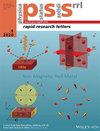Evidence of cationic antiphase disorder in epitaxial Cu(In,Ga)S2 grown on GaP/Si(001)
IF 2
4区 物理与天体物理
Q3 MATERIALS SCIENCE, MULTIDISCIPLINARY
引用次数: 0
Abstract
We present a transmission electron microscopy study of epitaxial Cu(In,Ga)S生长在 GaP/Si(001)上的外延铜(In,Ga)S2 中阳离子反相无序的证据
我们通过透射电子显微镜研究了在富铜或贫铜条件下,GaP/Si(001)上共蒸发的外延铜(In,Ga)S2(CIGS)薄膜。我们首先通过电子衍射揭示了不同相的空间分布和取向。通过对 CIGS 薄膜原子结构的原子分辨成像,我们得出结论:不同的黄铜矿畴在薄膜中共存,共享阳离子亚晶格的阳离子反相对称性。我们认为至少存在三种类型的阳离子反相边界(CAPBs),根据传播方向的不同,它们会或不会导致违反八进制规则。尽管我们观察到外延 CIGS 极易出现阳离子反相紊乱,但我们发现与贫铜生长条件相比,在富铜条件下生长 CIGS 会导致较低的 CAPB 密度。这就提出了 CAPB 对 CIGS 电子特性的影响问题。本文受版权保护。
本文章由计算机程序翻译,如有差异,请以英文原文为准。
求助全文
约1分钟内获得全文
求助全文
来源期刊

Physica Status Solidi-Rapid Research Letters
物理-材料科学:综合
CiteScore
5.20
自引率
3.60%
发文量
208
审稿时长
1.4 months
期刊介绍:
Physica status solidi (RRL) - Rapid Research Letters was designed to offer extremely fast publication times and is currently one of the fastest double peer-reviewed publication media in solid state and materials physics. Average times are 11 days from submission to first editorial decision, and 12 days from acceptance to online publication. It communicates important findings with a high degree of novelty and need for express publication, as well as other results of immediate interest to the solid-state physics and materials science community. Published Letters require approval by at least two independent reviewers.
The journal covers topics such as preparation, structure and simulation of advanced materials, theoretical and experimental investigations of the atomistic and electronic structure, optical, magnetic, superconducting, ferroelectric and other properties of solids, nanostructures and low-dimensional systems as well as device applications. Rapid Research Letters particularly invites papers from interdisciplinary and emerging new areas of research.
 求助内容:
求助内容: 应助结果提醒方式:
应助结果提醒方式:


